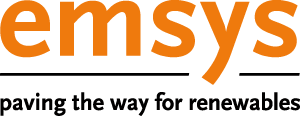Well prepared for Redispatch 2.0:
E.ON relies on innovative platform solution from energy & meteo systems
The future rules for the integration of renewable energies pose great challenges for all distribution system operators. The energy group E.ON has commissioned the energy and software specialist energy & meteo systems to develop and supply a customized redispatch system to ensure that its own distribution grids are well prepared for the new requirements.
Oldenburg, 17 September 2020 – To implement the new Redispatch 2.0 requirements, nine distribution system operators of the E.ON Group are relying on the know-how of energy & meteo systems. The German energy service provider provides an innovative software solution for the complete Redispatch 2.0 system. Already from October 2021 on all distribution system operators have to implement the new requirements. Due to the short deadline, both companies started working together immediately after signing the contract.
Redispatch 2.0 is an important milestone for the integration of renewable energies into the German power grids. Improved planning and forecasting processes will help to significantly reduce the frequency of grid bottlenecks. One of the new features of Redispatch 2.0 is that renewable energies and conventional small-scale producers must also be included in power plant scheduling. For distribution system operators this means a considerable extension of their tasks. (See paragraph "Background to Redispatch 2.0")
Manfred Grupe, Project Manager Redispatch at E.ON says: "Redispatch 2.0 is a big and very important project for E.ON. We have to redevelop and establish many processes. Due to the many wind and solar power plants in our grids, we also have to process huge data streams. We are convinced that the platform solution from energy & meteo systems will be able to handle the upcoming tasks safely. We also appreciate the agile form of cooperation. This is crucial if we are to meet the ambitious schedule".
Dr. Ulrich Focken, Managing Director of energy & meteo systems, explains: "We are very pleased about the trust that E.ON has placed in us. We started early on to develop suitable software for the Redispatch 2.0 requirements because our goal is to provide practical support for the improved integration of renewable energies. It also quickly became clear to us that the challenges of the new processes and the management of the data volumes required for them are right up our alley.
Modular software solution for high flexibility
The specially developed redispatch system from energy & meteo systems is called FuturePowerFlow. It is based on an innovative software architecture that uses flexibly deployable modules depending on requirements, connecting a wide variety of market players on a common platform. The system thus combines a high degree of functionality, flexibility and security.
The functional scope of the system includes all important processes of the new Redispatch 2.0 requirements. These include, among others, network analysis and bottleneck determination taking into account forecast data, as well as the determination of topology switching measures and redispatch dimensions while simultaneously identifying flexibility restrictions.
Important for the successful implementation are also extensive communication and data exchange processes with other grid operators ("NKK" mechanism) and further involved market participants, especially the plant operators ("PVK" mechanism). The FuturePowerFlow platform implements this communication in accordance with the Connect+ standard for uniform data exchange between grid operators.
A perfect fit for many E.ON requirements
The modular FuturePowerFlow redispatch solution from energy & meteo systems will be implemented at nine distribution system operators in the E.ON Group in the coming year. For each of these grid operators, energy & meteo systems will set up a separate redispatch system, taking into account the individual requirements. In view of the approaching implementation deadline in October 2021, the project is being implemented very agilely in order to be able to react quickly and precisely to challenges and changes in the concrete implementation.
Redispatch 2.0
If there is a threat of bottlenecks in the power grid, for example because too much wind or solar energy is feeding into the networks, grid operators must take action to ensure the stability of the grids. In this process, known as "Redispatch", various connected generation plants are shut down and, if necessary, others are restarted to avoid overloading the networks. Up to now, this has generally only affected conventional power plants with a capacity of more than ten megawatts, which are mostly connected to the high and extra-high voltage networks.
An amendment to the Network Expansion Acceleration Act (NABEG 2.0) now requires that renewable energy plants with a capacity of more than 100 kilowatts be included from October 2021. The process known as "Redispatch 2.0" presents distribution system operators with new challenges. In the future, their extended areas of responsibility will include, for example: 1. coordinated redispatch planning with all downstream grid and plant operators; 2. continuous bottleneck identification, taking into account generation and load forecasts in the network area; 3. transmission of extensive energy data for modelling and calculating the existing flexibility potential; 4. operation of a dedicated ICT infrastructure for data collection and control of the generation plants; and 5. organization of imbalance adjustment and financial compensation in the event of interventions in the power plant plan.
More about: FuturePowerFlow

